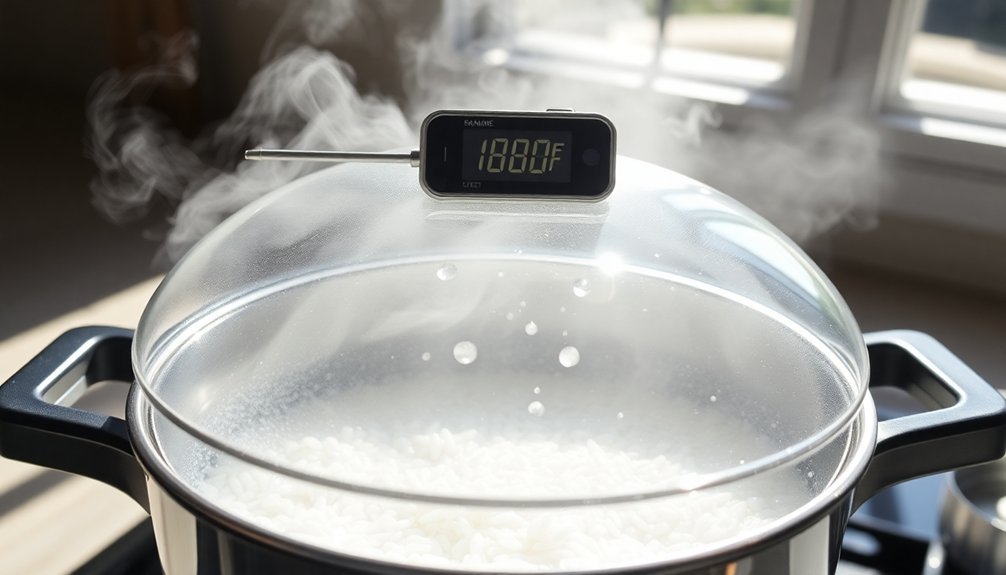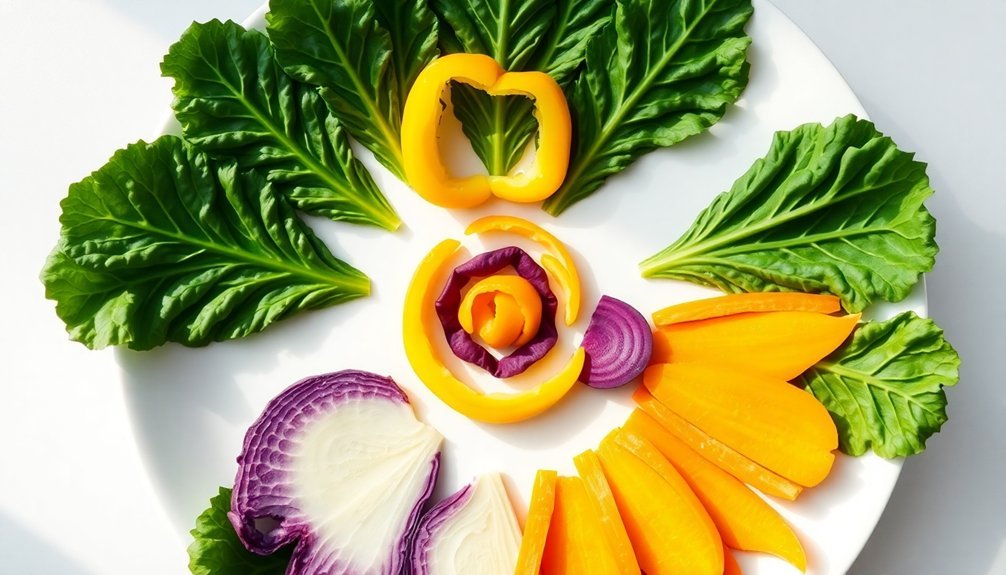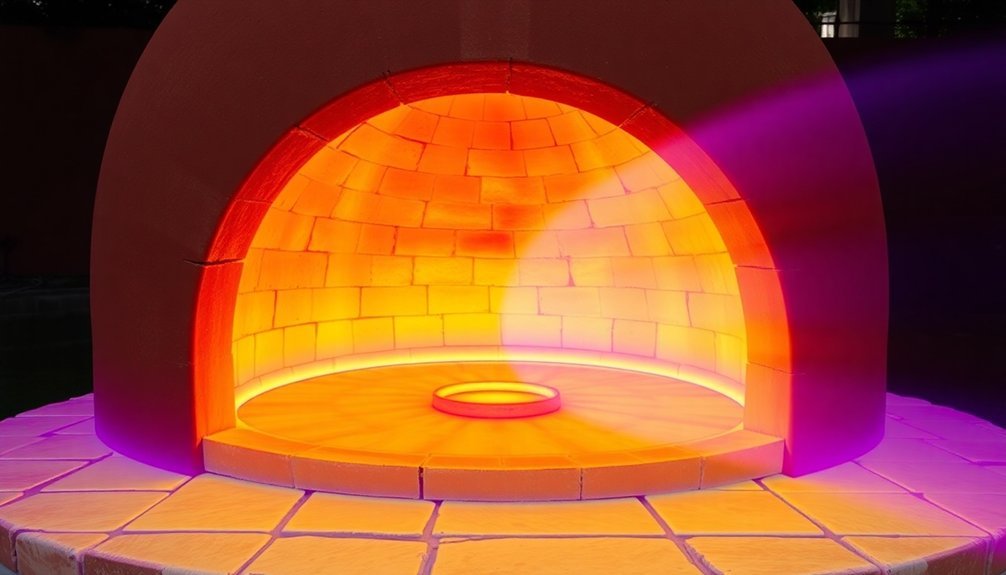To cook jasmine rice using solar power, you'll need a solar oven that can reach 375°F to 550°F with adjustable reflectors. Use a matte black cooking vessel, preferably stainless steel, and verify it has a clear glass or plastic cover to trap heat. Position your solar cooker between 11:00 am and 3:00 pm on bright, sunny days, with 30-45 minutes of direct sunlight needed. Keep the reflectors clean and properly aligned with the sun throughout cooking. Protect your setup from wind and maintain proper insulation for even heating. Exploring the right setup techniques will help you achieve perfectly cooked solar rice every time.
Essential Solar Cooking Equipment

Before diving into solar rice cooking, you'll need specialized equipment designed to harness the sun's energy effectively. Your solar oven should include adjustable panels or reflectors that maximize sun exposure, capable of reaching temperatures between 375°F and 550°F, depending on the model you choose.
You'll need a solar oven with integrated panels and parabolic reflectors to concentrate sunlight onto your cooking area. The reflectors should be adjustable to track the sun's movement throughout the day, guaranteeing consistent heat. Look for high-specular reflection materials that efficiently channel light into the cooking space. Whether you choose a box or panel cooker will determine your cooking style and temperature ranges.
Your cooking vessel is essential – select a matte black pot or pan to maximize heat absorption. Stainless steel or specialized cooking trays work best, and you'll want to verify they're either non-stick or lightly oiled to prevent the rice from sticking.
The cooking chamber should include a clear plastic or glass cover to trap heat effectively.
Don't forget important accessories like stabilizing stands and cleaning brushes. Many solar ovens come with silicone cooking pans and additional features like EVA frames and extra reflectors to enhance performance.
Optimal Weather Conditions
Now that you've assembled your solar cooking equipment, success with jasmine rice depends heavily on selecting the right weather conditions for cooking.
You'll want to plan your cooking between 11:00 am and 3:00 pm when the sun is directly overhead, though you can start as early as 10:00 am during winter months. Make sure to wear eye protection when setting up your equipment.
Choose a bright, sunny day with minimal cloud cover – you'll need at least 30-45 minutes of direct sunlight per hour to maintain safe cooking temperatures.
Don't attempt to cook on overcast days, as this can lead to spoiled rice and unsafe conditions. Even on cold days, your solar oven can reach high temperatures if there's consistent sunshine.
You'll need to protect your setup from wind, which can disturb your oven's stability and cooking performance.
Find a sheltered location that still receives full sun exposure.
While outside temperature isn't vital for success, proper insulation is key.
Your well-insulated solar oven can maintain the necessary heat for cooking jasmine rice regardless of ambient temperature, as long as you've got steady sunlight and protection from strong winds.
Setting Up Solar Reflectors

Proper setup of your solar reflectors plays an essential role in achieving the right temperature for cooking jasmine rice.
You'll need to position your solar cooker directly facing the sun and adjust the tilt for maximum exposure. If you're using a parabolic cooker, place your rice pot precisely at the focal point where sunlight converges.
Clean reflectors are vital for efficient cooking, so make sure they're free from dust and debris. You can verify proper positioning by standing between the sun and cooker – you should see the pot clearly in all reflective panels. With a well-positioned setup, you can join the ranks of over 5,000 dishes being prepared daily in public kitchens using solar technology.
Whether you're using a box cooker, panel system, or parabolic design, you'll need to periodically adjust the position to track the sun's movement.
For best rice cooking results:
- Position multiple reflectors around your cooking vessel to direct additional sunlight and increase heat capture.
- Use sturdy blocks or books to maintain the ideal angle, preventing any wind disruption.
- Keep monitoring the reflector alignment throughout the cooking process, making adjustments as needed.
Remember to wear protective gear when handling the cooker, as properly aligned reflectors can generate intense heat.
Temperature Control Methods
Mastering temperature control is essential for perfectly cooked jasmine rice, whether you're using a stovetop, Instant Pot, or rice cooker.
For stovetop cooking, you'll need to bring water to a boil over medium or high heat, then reduce it to low. Use a smaller burner for simmering and avoid lifting the lid to maintain temperature.
Select a non-stick pot or lightly oil a stainless steel one to prevent sticking. You'll simmer for 15-18 minutes, then let it steam for a few minutes after cooking.
If you're using an Instant Pot, select the "Rice" button or cook on high pressure for 3 minutes. Use a 1:1.25 to 1:1.5 water-to-rice ratio, and ascertain the valve is set to "sealing."
Let the pressure release naturally for 10 minutes before opening.
Rice cookers offer the simplest temperature control – just use a 1:1.25 water-to-rice ratio, press cook, and let the machine handle the rest.
It'll automatically switch to warm mode when done. For all methods, let the rice rest covered for a few minutes before fluffing with a fork to achieve perfect texture.
Jasmine Rice Cooking Times

Depending on your cooking method, jasmine rice requires specific timing to achieve ideal results.
Whether you're using a stovetop, rice cooker, Instant Pot, or microwave, each method demands different timing considerations for perfect, fluffy rice.
On the stovetop, you'll need 15-20 minutes of total cooking time, plus 10-15 minutes of rest time. The process includes bringing water to a boil for 2-3 minutes, then simmering for 10-18 minutes.
Rice cookers simplify the process by managing the cooking time automatically, requiring only a few minutes of rest time before the unit switches to warm mode.
- The Instant Pot offers the fastest cooking method, requiring just 5 minutes under pressure and 10 minutes for natural pressure release.
- Microwave cooking takes about 15 minutes total (5 minutes on High, 10 on Medium), followed by 10 minutes of rest time.
Don't skip the resting period for any cooking method, as it's essential for achieving the right texture.
Remember to fluff your rice with a fork or wooden spoon after the rest period, regardless of your chosen cooking method.
Frequently Asked Questions
Can Leftover Solar-Cooked Jasmine Rice Be Safely Stored for Next-Day Consumption?
Yes, you can safely store leftover rice by cooling it to 40°F within 4 hours, placing it in an airtight container, and refrigerating it. You'll need to reheat it to 165°F before eating tomorrow.
Does Altitude Affect Solar Cooking Temperatures for Jasmine Rice?
Yes, altitude will affect your solar cooking temps. While you'll get more intense solar radiation at higher elevations, the lower boiling point means you'll need to adjust cooking times for your rice accordingly.
What Alternative Grains Can Be Cooked Using the Same Solar Method?
You can successfully cook white rice, brown rice, basmati rice, quinoa, oats, and various legumes like lentils and chickpeas using solar methods. Just adjust the water ratios and cooking times for each grain.
How Does Humidity Impact the Solar Cooking Process for Rice?
You'll find that high humidity slows down your rice cooking by reducing heat gain and increasing heat loss. It'll affect the gelatinization process and may require adjusting your water-to-rice ratio for proper results.
Can Solar-Cooked Jasmine Rice Be Used for Making Traditional Asian Desserts?
You can use solar-cooked jasmine rice for Asian desserts, but you'll need to adjust moisture levels and cooking times. Consider adding thickeners or extra coconut milk to achieve the right consistency for traditional recipes.
In Summary
You'll find solar cooking jasmine rice is both eco-friendly and rewarding once you've mastered the basics. By maintaining 180-200°F with proper reflector positioning and monitoring your solar cooker's temperature gauge, you'll achieve perfectly fluffy rice in about 45 minutes. Remember to adjust cooking times based on sun intensity and altitude, and don't forget to let your rice rest for 10 minutes before serving.





Leave a Reply